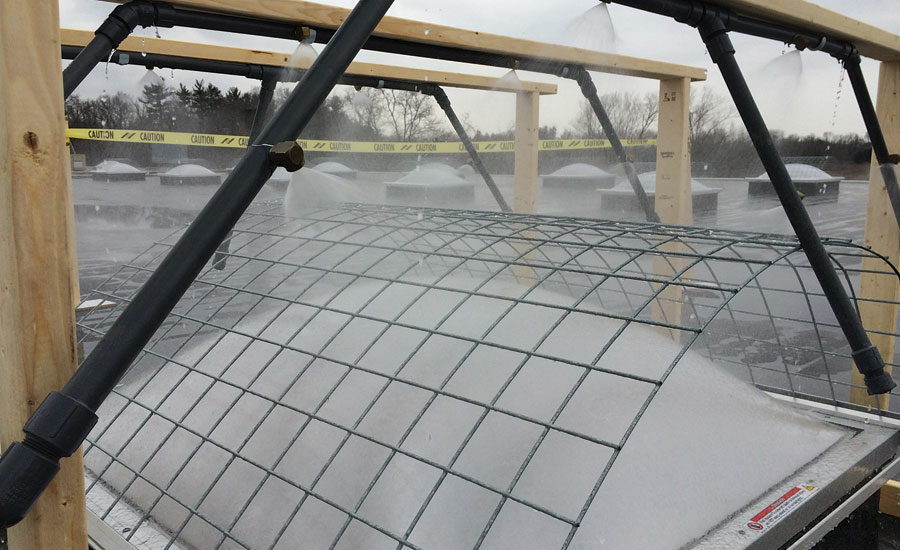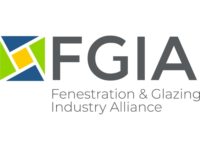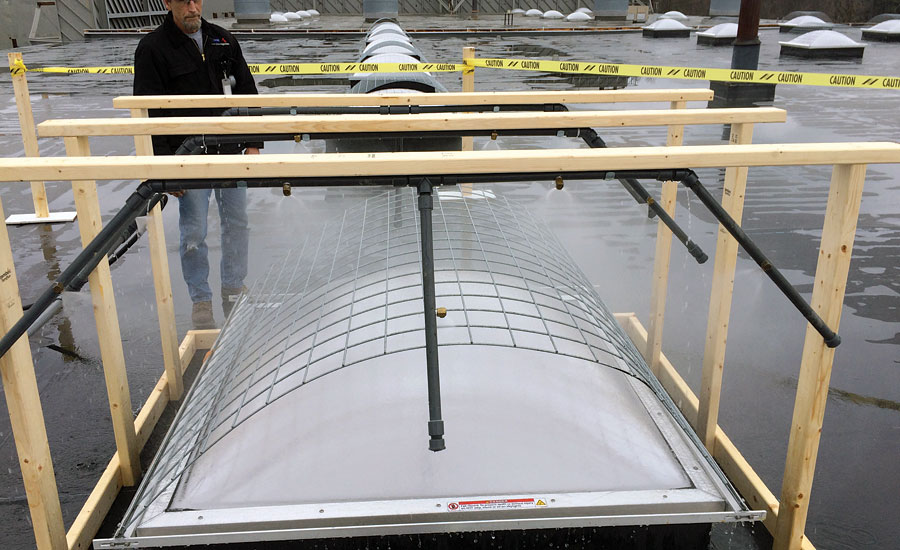Field Testing Skylights
Leak Insurance

Field testing during or immediately following construction and prior to occupancy is recommended to verify the actual installed performance of fenestration products.

A calibrated spray rack applies water against the outside surface while technicians observe for any water penetration at the interior.

Defining the acceptance criteria and field testing requirements in the project specification, and performing the tests can help determine if problems are present and aid in corrective action.



Many years ago, when rudimentary skylights were little more than holes in the roof covered in an ad hoc manner with a piece of glass, they were—often justifiably—viewed with suspicion for their propensity to leak water.
Obviously, skylight designs have advanced radically to the point that faulty design is not likely to be the cause of leakage problems. Furthermore, products that meet the code-mandated AAMA/WDMA/CSA 101/I.S.2/A440, the North American Fenestration Standard/Specification for Windows, Doors, and Skylights (NAFS), must pass pressure-impelled laboratory water leakage spray tests of increasing stringency, depending on the applicable on-site Design Pressure (DP) as based on the wind speed contour maps of ASCE/SEI 7?10, Minimum Design Loads for Buildings and Other Structures. NAFS-2011 calls for a minimum design pressure for skylights of 1440 Pa.
For either glass-glazed or plastic-glazed unit skylights, NAFS-2011 sets the minimum water resistance test pressure at 15 percent of design pressure, or 220 (Pa).
Despite the rigor of such tests, improper or poorly executed installation procedures can defeat the best product designs. This is also in spite of the availability of installation guidelines such as AAMA 1607, Voluntary Installation Guidelines for Unit Skylights.
Specifiers are therefore well advised to require verification of the actual installed performance of fenestration products by insisting on field testing during or immediately following construction and prior to occupancy.
Simulating Real World Conditions
When properly applied, field testing is a useful way to verify actual installed performance. The key is testing under conditions that accurately simulate the real-world environment and ensuring that the appropriate test method is applied to the specific installation.
AAMA 502, Voluntary Specification for Field Testing of Newly Installed Fenestration Products, is the proper test method for verifying field air leakage and water penetration resistance of newly installed fenestration (curtain walls, sloped glazing and storefront systems excluded) prior to issuance of the building occupancy permit, but in no case later than six months after installation.
AAMA 502 bases its testing protocols on ASTM E1105, Standard Test Method for Field Determination of Water Penetration of Installed Exterior Windows, Skylights, Doors, and Curtain Walls, by Uniform or Cyclic Static Air Pressure Difference; and E783, Standard Test Method for Field Measurement of Air Leakage through Installed Exterior Windows and Doors.
A Recipe for Test Pressure
To implement AAMA 502 for unit skylights, a temporary sealed test chamber is attached, typically, to the interior of the installed unit, but may be installed on the outdoor side. Air is supplied to or evacuated from the test chamber at the rate necessary to establish and maintain the desired air pressure difference across the entire skylight and its perimeter seals. For water penetration testing, this pressure is equal to two-thirds of the water test air pressure (WTP) prescribed by NAFS. In the case of unit skylights that have been lab tested to NAFS-11, this translates to 147 Pa (3.06 psf) in the field. (Note that, due to changes in requirements, the applicable minimum test pressure will be different for skylights laboratory tested and rated per NAFS-08 or -05).
This one-third reduction of the test pressure for field testing is considered to be a reasonable adjustment to account for the variables inherent in a field test environment. Units laboratory tested at higher design pressures than the minimum specified in NAFS will of course have to be tested at a correspondingly higher test pressure in the field per AAMA 502.
Once the test pressure is established, a calibrated spray rack applies water against the outside surface while technicians observe for any water penetration at the interior. Note that, while the water application is at a very high rate, its purpose is only to keep the outdoor surface well coated with a film of water; it’s the differential air pressure that will drive water through any potential leakage points.
AAMA 502 also provides for an air leakage resistance test for skylights, which—unlike the water penetration test—is conducted per ASTM E783 at the same applied pressure as used to qualify the unit in the laboratory under NAFS (75 Pa [1.57 psf]), or other higher value if so specified. However, while the acceptable air infiltration rate for skylights is 1.5 L/s•m2 (0.30 cfm per-square-foot) in the lab, 502 specifies 150 percent of the lab leakage figure in field testing, which comes to 2.3 L/s•m2 (0.45 cfm-per-square-foot).
The Importance of Early Testing
Once completed, changes needed to repair a skylight installation can be very difficult and expensive. Thus, defining the acceptance criteria and field testing requirements in the project specification, and performing the tests as soon as practical before a substantial portion of the project is completed (but no later than six months after installation) can help determine if problems are present and aid in corrective action. Testing prior to the installation of drywall and interior finish can reveal design, fabrication and installation weaknesses at a time when responsibility for the problems can be assigned and remedial action can be most effective, relatively simple, and less expensive.
AAMA 502 provides a recommended short form model specification that allows the specifier to prescribe the test protocol and the test pressure for both air infiltration and water penetration resistance.
Forensic Investigation of Existing Fenestration
AAMA 511, Voluntary Guideline for Forensic Water Penetration Testing of Fenestration Products, addresses situations that may arise where a forensic investigation of an actual known leakage problem in an occupied building is needed to pinpoint the leakage path by recreating the known water leaks. AAMA 511 does this through research and simulation of the weather events that produced the reported water penetration.
AAMA 511 expands on the investigative process set forth in ASTM E2128, Standard Guide for Evaluating Water Leakage of Building Walls, which recommends a total of seven investigative, review and preparatory steps prior to actual testing, as well as post-testing steps. Pretest inspection and data gathering include a review of project documents, evaluation of the design concept, a review of service history and inspections—all aimed at developing a hypothesis for the source of the water intrusion.
The process begins by calculating the differential air pressures that the suspect specimens experienced during the actual wind-driven rain event conditions coinciding with the original leak. This calculated pressure defines the test pressure to which the product is then subjected during actual field testing. If this calculated wind pressure is greater than two-thirds of the rated WTP for the product, it may be that the product was not the most appropriate selection for the project. The investigative process then moves to actual testing, the protocol for which is similar to that of AAMA 502, but with the added option of pressurizing either the unit skylight alone, or to include the perimeter joint.
Using a Qualified Tester
Note that AAMA field testing requires that the indicated testing must be performed by an AAMA-accredited testing laboratory, i.e., one recognized as meeting the current requirements of AAMA 204, Guidelines for AAMA Accreditation of Independent Laboratories Performing On-Site Testing of Fenestration Products. This ensures that the laboratory has the qualified staff and equipment to properly perform field testing.
AAMA 502, AAMA 511, AAMA 1607 and NAFS, along with all other AAMA documents, may be obtained from the AAMA Publications Store at www.aamanet.org.
Looking for a reprint of this article?
From high-res PDFs to custom plaques, order your copy today!




.png?height=200&t=1730377465&width=200)


